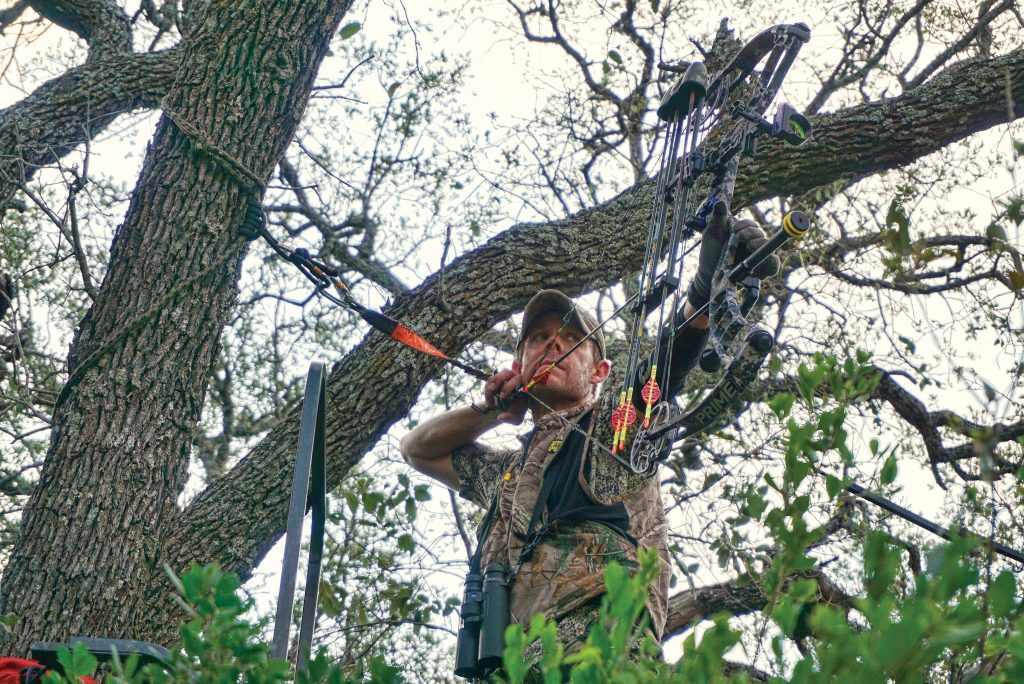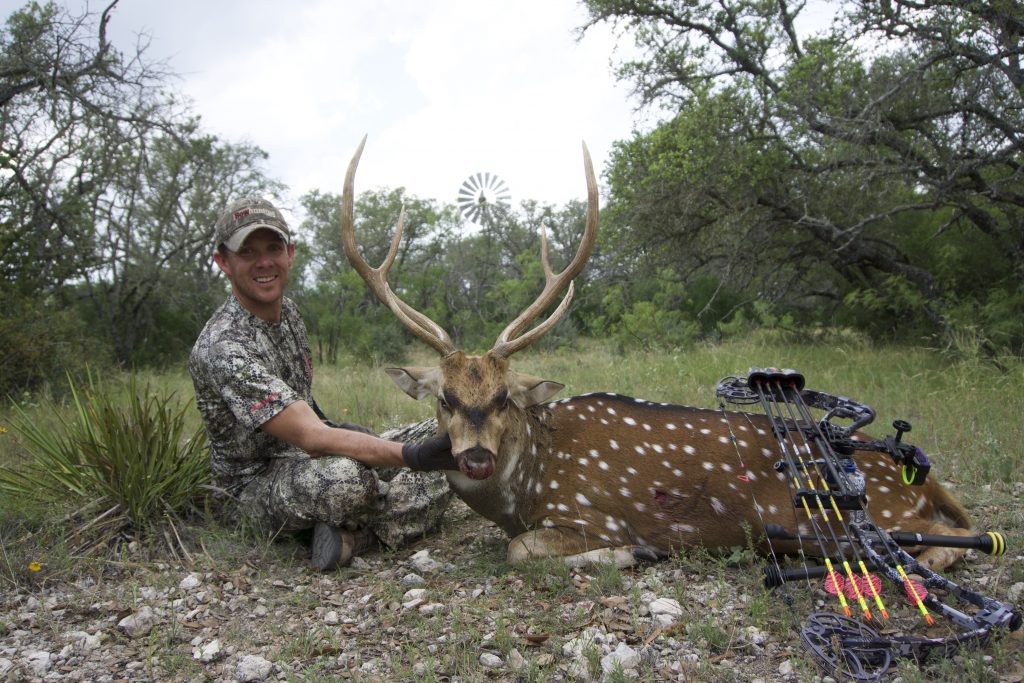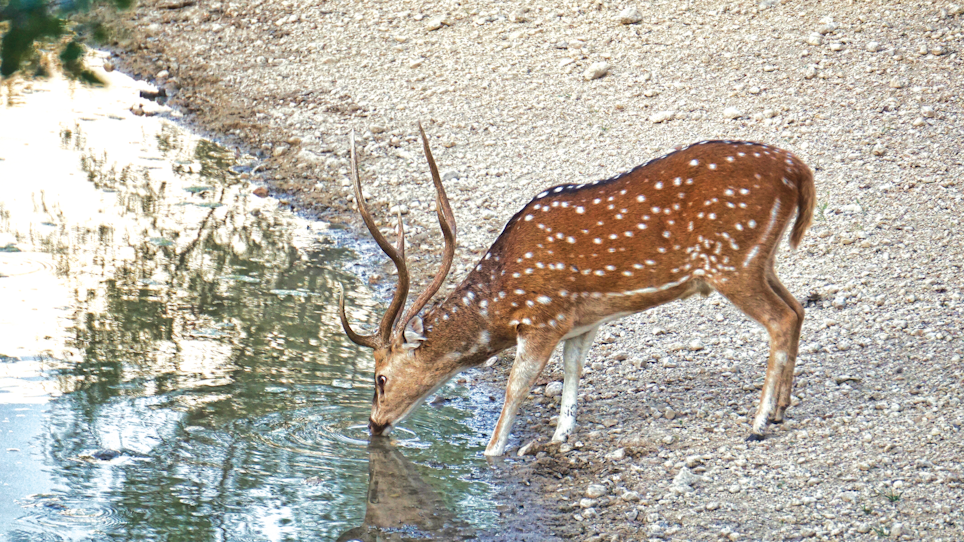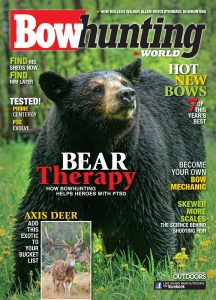Yes, I’m a turkey nut and a bear addict, but I’m also drawn to the challenge of chasing unfamiliar game in new landscapes. I first laid eyes on these magnificent beasts during a Texas whitetail foray. Their three-pronged elk-like antlers, brilliant white spots and almost-orange coats captivated me, and a new adventure began to form in my bowhunting brain.
The chital, or axis, is native to India, but was introduced into the Lone Star State in 1932. The species adapted extremely well to the climate and landscape, and by 1988, self-sustaining herds were thriving in 27 central and southern Texas counties. The largest population of axis is found on the Edwards Plateau where the landscape is similar to that of India. Today, axis deer are the most abundant ungulate in Texas and, because they are considered to be “exotic” by the Texas Parks and Wildlife department, may be hunted year-round with a very inexpensive (when compared against other big-game licenses) non-resident 5-day special hunting license ($48).
Texas Or Bust
Accompanied by my wife, Amy, and 11-year-old son, Hunter, I pointed the Chevy south in late May. Our destination: the Canyon Ranch. We would be hunting with my good friend and owner of SOE Hunts, Mike Stroff. With access to vast amounts of acreage harboring one of the largest herds of free-ranging axis on the Edwards Plateau (and knowing Mike to be a savvy hunter), I was excited to see what the week would bring.
I hunted the Canyon Ranch before, but never during the spring. The foliage was a brilliant green, birds boasting unimaginable colors sailed through the clear blue sky and the warm breeze whistled through the mesquite. Gorgeous. The lodge was just as I’d remembered it — a real family place with private, comfortable rooms. And the meals are first class. To this day, I think my wife talks more about the setting of the lodge and the amazing food than the monster axis she encountered.
With our gear unloaded and our weapons checked, Mike got us out the door for our first evening in the Texas Hill Country. My wife and son were rifle hunting together on a different piece of the property, and it didn’t take long for their cherry-red Suburban to disappear into the thick Texas brush. The moment it did, Mike took a right on a no-name ranch road.
“This is a good stand,” Mike said. “You’re in a lock-on in a big oak, and there is a natural spring directly in front of you. We’ve been seeing some good rutting activity and some good bucks in the area. Stay alert, and be sure to hold out for a good one.”
After attaching my carabineer to the Hunter Safety System Lifeline, I made my way up the gnarled oak. It was a beautiful spot, and I hadn’t been in the stand long when I heard it. To this day I can’t explain the sound. Axis hunters call it a roar, but I would best describe it simply as a scary sound — a sound you wouldn’t want to hear while creeping through the woods on Halloween night. Catch my drift?
Throughout the evening I heard a number of other roars and barks, and I even caught a few glimpses of some distant axis sporting splendid headgear. But aside from a few does and raghorns, none quenched their thirst at the spring.
My wife and son, on the other hand, had a more eventful evening at their refreshment stand. My wife harvested a massive axis, and my son dropped the hammer on a nice hog. Yes, this is how the Bauserman clan vacations. No lines. No traffic. Just time together in God’s great outdoors. I highly recommend it.
Related: Why You Should Hunt Axis Deer Year-Round With A CrossbowAxis Tip #1: Why Water?
One of the reasons I fell in love with hunting axis was because hunting these beautifully marked creatures reminded me of chasing my first bowhunting love — pronghorn. When the temperatures climb and the humidity rises, thirsty males and females seek secluded water holes from which to slurp. The rut only intensifies waterhole use, as run-ragged females come to quench their thirst. Because axis reproduce throughout the year, the “rut” is hard to put a finger on. No matter what time of the year you decide to hunt axis, you will see males boasting hard-horned antlers while others are in full velvet or just starting growth. However, the hardest rut, especially in this region, occurs during late May and throughout the month of June. If you find a water source smack in the middle of a serious breeding ground occupied by several bucks, you could be in for an epic sit.
A Vocal Bunch
The morning of Day 2 dawned, and I couldn’t have asked for a more pristine location. Perched in a curvaceous oak, I took time to soak in the beauty of the massive pond in front of me. As the sun climbed farther into the eastern sky, the jungle around me began to shake. I’ve never heard so many axis bucks roaring at one time. It was unbelievable. My head was spinning. It felt like I was back home in Colorado perched over a red-hot wallow during the month of September, only more intense. Though their regular bellows and growls aren’t as loud or crisp as the bugle of a North American elk, their vocal nature reminded me of their distant kin. In addition to listening to their songs of courtship, I heard the unmistakable sound of clashing horns more than once, and I spied a massive buck ripping a monstrous cedar branch to shreds. I remember sitting in the tree that morning and saying to myself, “My gosh, it’s like hunting a pronghorn and an elk at the same time.”
Finally, around 9 a.m. a mature axis wandered into the waterhole. He was gorgeous. His white spots were so pronounced, and the dark streak running down the center of his back was more beautiful than I imagined. Like a fleet-footed pronghorn, the buck was cautious as he approached the pond. He tilted his nose into the breeze and scanned the perimeter multiple times before lowering his head to drink. He was 67 yards away, but with four days left to hunt, I didn’t even pick up my bow. Four other mature bucks and a handful of does visited the water during my morning sit, but all of them stayed just out of range.

The author always takes the opportunity to draw and settle his pin on objects — rocks, brush and the like — multiple times from his above-ground perch so when the moment of truth arrives he's ready.
Axis Tip #2: Camo And Ozonics
Yes, these critters are exotics, but they are free-ranging exotics and are as wary as any creature I’ve ever bowhunted. One whiff of human odor, and they are gone. One glimpse of something that doesn’t look right to them, and all you’ll see is an orange body fleeing in the opposite direction. Whether you’re spotting and stalking or sitting in a treestand, choose a camo pattern that matches the terrain you’re hunting. Long before my hunt, I asked Mike multiple questions about the color of the vegetation in the area and studied pictures of the spring landscape on Google Earth. My pattern of choice for the hunt was Badlands Approach pattern. The pattern boasts a neutral color palette and allows the greens within the pattern to really pop in the bright sunlight.
When in the tree, I had my Ozonics HR-200 running the entire time. Typically, Texas winds are predictable, but on the Edwards Plateau, snaking canyons and broken landscapes create fickle winds. The HR-200 saved me on this hunt more than once.
A Rut-Crazed Buck
I toted a Hooyman back to the stand with me for the evening hunt. I wasn’t about to leave the rut fest I’d experienced that morning, but I did want to trim a few oak limbs to extend my shooting range a bit. After carving away some branches and painting a few spots around the pond with my rangefinder, I slid into the seat of my stand and let the evening unfold.
It was 2 p.m., and it was hot. A few doe axis came and went, but none had a big rack in tow. A big, mature black buck did waltz right under my stand and quench his thirst at a chip-shot distance of 18 yards, but I had my heart set on axis and left my bow on its hanger. In addition to the black buck and axis, several Rio Grande turkey and a number of whitetails visited my little jungle oasis. God bless Texas!
As the evening shadows grew longer, the roars, bellows and growls intensified, just like is often the case in the Rocky Mountain West. On more than one occasion, I spied the same buck moving an estrous doe from a herd, and three satellite bucks circled in the distance. Then, without warning, a doe materialized out of an oak mott to my right. Hot on her tail was a mature axis buck. It was amazing. He was rutting her like a mature whitetail. He’d obviously singled the doe out and had been tailing her for who knows how long. The doe looked exhausted and headed straight for the water. The buck on the other hand had no interest in slaking his thirst. He stood on the edge of the dam and waited for his lady companion to finish drinking. The range was 35 yards, and I pressed my Prime Rize into action. The buck was totally occupied with the doe. He seemed relaxed, so I felt no need to hold low. The shot broke, and the arrow found its mark. The shot was perfect — mid-body and right behind the front shoulder. The buck collapsed within sight.

Axis hunting is an amazing experience chasing gorgeous creatures in a magnificent landscape. It's a hunt you don't have on your bucket list, but you should.
I was still doing my celebration dance when a pair of younger axis popped through the same opening and began harassing the doe. What an incredible species of deer to hunt, one that gave me the feeling I was hunting pronghorn, elk and whitetail all at the same time. We will be back.
Related: 5 Reasons The Axis Deer Is A Must-Bowhunt Species!
Axis Tip #3: You Get It All With The Rut
While axis bucks may be seen with large harems, they make no attempt to keep harems together like rutting bull elk. Rather, bucks seek out and service individual does as they become receptive, just like a mature whitetail. After tagging my buck, I spent my remaining days spotting and stalking doe axis with my son. During that time, I watched 12 different bucks chase individual does and display the chase tactics of a mature whitetail. However, those bucks would stop often, tilt their heads back and roar, just like an elk. They also boast the keen vision and nervous nature of a pronghorn.
As for the meat, well, it’s to die for. If I had to select one wild game species to eat for the rest of my life, it would be axis.
So, consider a venue change this spring and head to the Lone Star State with your family for some rutting axis action. It’s just like Disney World, only better!







